Wajdi Zaghouani
Northwestern University in Qatar
EmoHopeSpeech: An Annotated Dataset of Emotions and Hope Speech in English and Arabic
May 17, 2025Abstract:This research introduces a bilingual dataset comprising 23,456 entries for Arabic and 10,036 entries for English, annotated for emotions and hope speech, addressing the scarcity of multi-emotion (Emotion and hope) datasets. The dataset provides comprehensive annotations capturing emotion intensity, complexity, and causes, alongside detailed classifications and subcategories for hope speech. To ensure annotation reliability, Fleiss' Kappa was employed, revealing 0.75-0.85 agreement among annotators both for Arabic and English language. The evaluation metrics (micro-F1-Score=0.67) obtained from the baseline model (i.e., using a machine learning model) validate that the data annotations are worthy. This dataset offers a valuable resource for advancing natural language processing in underrepresented languages, fostering better cross-linguistic analysis of emotions and hope speech.
An Annotated Corpus of Arabic Tweets for Hate Speech Analysis
May 17, 2025Abstract:Identifying hate speech content in the Arabic language is challenging due to the rich quality of dialectal variations. This study introduces a multilabel hate speech dataset in the Arabic language. We have collected 10000 Arabic tweets and annotated each tweet, whether it contains offensive content or not. If a text contains offensive content, we further classify it into different hate speech targets such as religion, gender, politics, ethnicity, origin, and others. A text can contain either single or multiple targets. Multiple annotators are involved in the data annotation task. We calculated the inter-annotator agreement, which was reported to be 0.86 for offensive content and 0.71 for multiple hate speech targets. Finally, we evaluated the data annotation task by employing a different transformers-based model in which AraBERTv2 outperformed with a micro-F1 score of 0.7865 and an accuracy of 0.786.
Propaganda to Hate: A Multimodal Analysis of Arabic Memes with Multi-Agent LLMs
Sep 11, 2024



Abstract:In the past decade, social media platforms have been used for information dissemination and consumption. While a major portion of the content is posted to promote citizen journalism and public awareness, some content is posted to mislead users. Among different content types such as text, images, and videos, memes (text overlaid on images) are particularly prevalent and can serve as powerful vehicles for propaganda, hate, and humor. In the current literature, there have been efforts to individually detect such content in memes. However, the study of their intersection is very limited. In this study, we explore the intersection between propaganda and hate in memes using a multi-agent LLM-based approach. We extend the propagandistic meme dataset with coarse and fine-grained hate labels. Our finding suggests that there is an association between propaganda and hate in memes. We provide detailed experimental results that can serve as a baseline for future studies. We will make the experimental resources publicly available to the community.
MemeMind at ArAIEval Shared Task: Spotting Persuasive Spans in Arabic Text with Persuasion Techniques Identification
Aug 08, 2024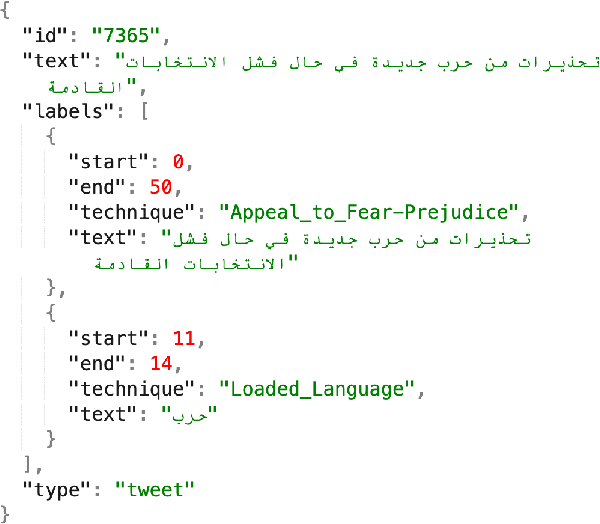
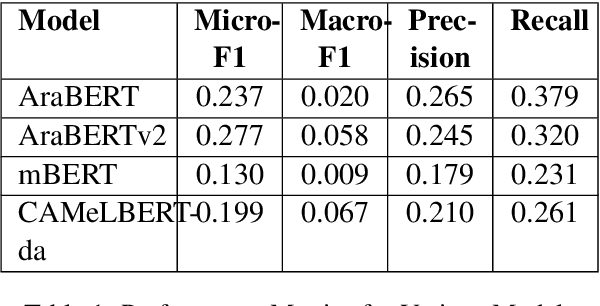
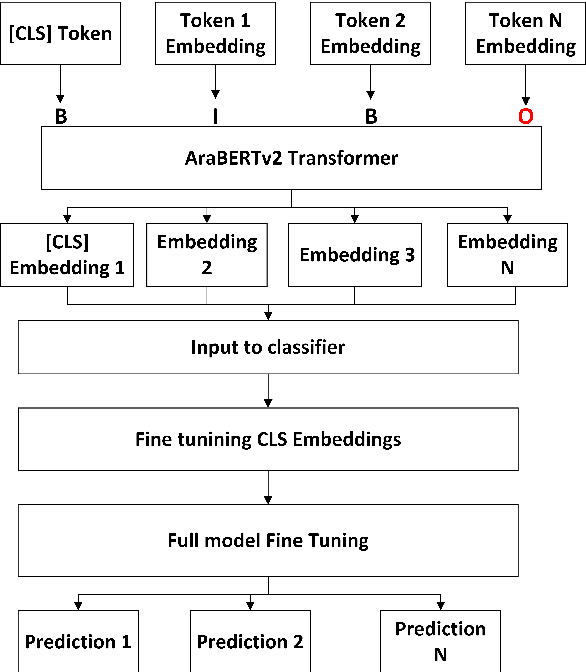

Abstract:This paper focuses on detecting propagandistic spans and persuasion techniques in Arabic text from tweets and news paragraphs. Each entry in the dataset contains a text sample and corresponding labels that indicate the start and end positions of propaganda techniques within the text. Tokens falling within a labeled span were assigned "B" (Begin) or "I" (Inside), "O", corresponding to the specific propaganda technique. Using attention masks, we created uniform lengths for each span and assigned BIO tags to each token based on the provided labels. Then, we used AraBERT-base pre-trained model for Arabic text tokenization and embeddings with a token classification layer to identify propaganda techniques. Our training process involves a two-phase fine-tuning approach. First, we train only the classification layer for a few epochs, followed by full model fine-tuning, updating all parameters. This methodology allows the model to adapt to the specific characteristics of the propaganda detection task while leveraging the knowledge captured by the pre-trained AraBERT model. Our approach achieved an F1 score of 0.2774, securing the 3rd position in the leaderboard of Task 1.
The FIGNEWS Shared Task on News Media Narratives
Jul 25, 2024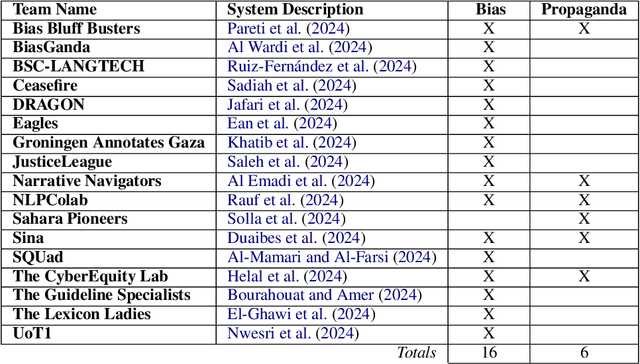
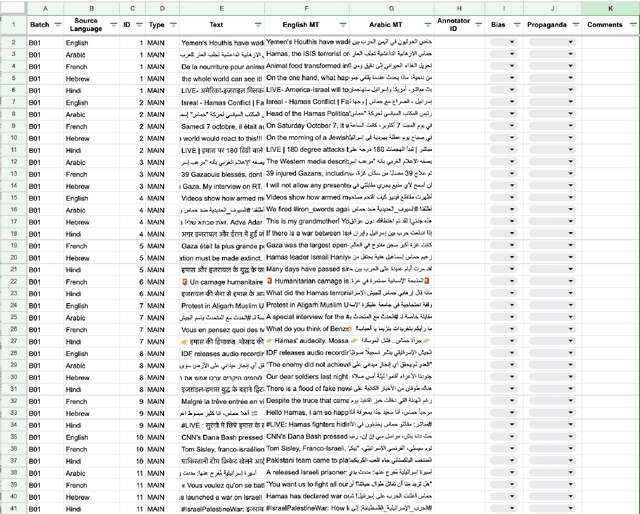
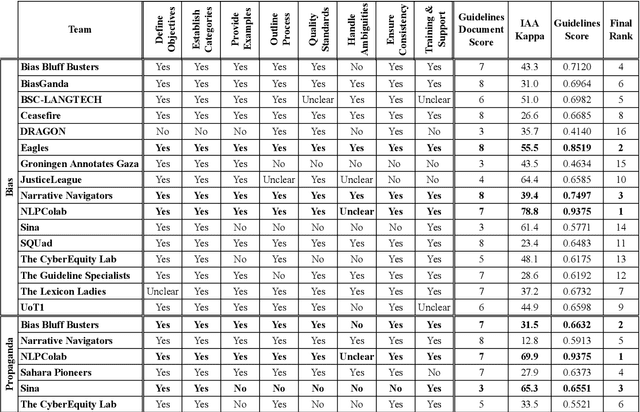
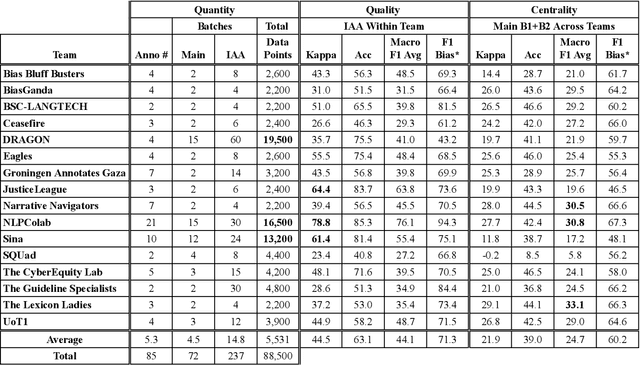
Abstract:We present an overview of the FIGNEWS shared task, organized as part of the ArabicNLP 2024 conference co-located with ACL 2024. The shared task addresses bias and propaganda annotation in multilingual news posts. We focus on the early days of the Israel War on Gaza as a case study. The task aims to foster collaboration in developing annotation guidelines for subjective tasks by creating frameworks for analyzing diverse narratives highlighting potential bias and propaganda. In a spirit of fostering and encouraging diversity, we address the problem from a multilingual perspective, namely within five languages: English, French, Arabic, Hebrew, and Hindi. A total of 17 teams participated in two annotation subtasks: bias (16 teams) and propaganda (6 teams). The teams competed in four evaluation tracks: guidelines development, annotation quality, annotation quantity, and consistency. Collectively, the teams produced 129,800 data points. Key findings and implications for the field are discussed.
Nullpointer at CheckThat! 2024: Identifying Subjectivity from Multilingual Text Sequence
Jul 14, 2024
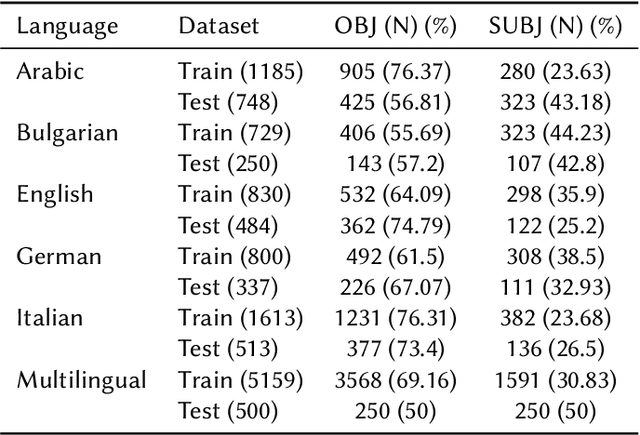

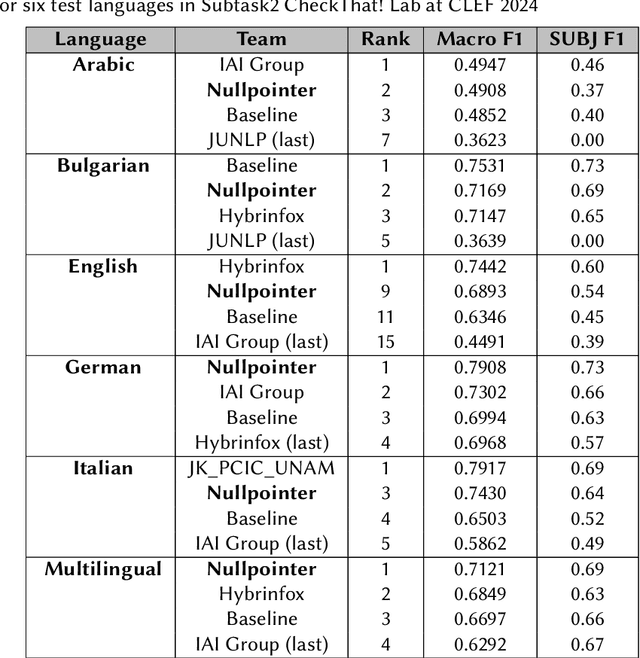
Abstract:This study addresses a binary classification task to determine whether a text sequence, either a sentence or paragraph, is subjective or objective. The task spans five languages: Arabic, Bulgarian, English, German, and Italian, along with a multilingual category. Our approach involved several key techniques. Initially, we preprocessed the data through parts of speech (POS) tagging, identification of question marks, and application of attention masks. We fine-tuned the sentiment-based Transformer model 'MarieAngeA13/Sentiment-Analysis-BERT' on our dataset. Given the imbalance with more objective data, we implemented a custom classifier that assigned greater weight to objective data. Additionally, we translated non-English data into English to maintain consistency across the dataset. Our model achieved notable results, scoring top marks for the multilingual dataset (Macro F1=0.7121) and German (Macro F1=0.7908). It ranked second for Arabic (Macro F1=0.4908) and Bulgarian (Macro F1=0.7169), third for Italian (Macro F1=0.7430), and ninth for English (Macro F1=0.6893).
ArAIEval Shared Task: Propagandistic Techniques Detection in Unimodal and Multimodal Arabic Content
Jul 05, 2024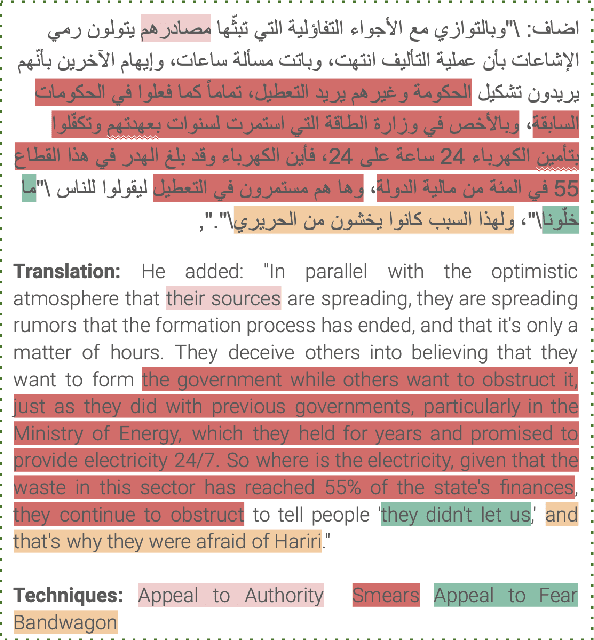
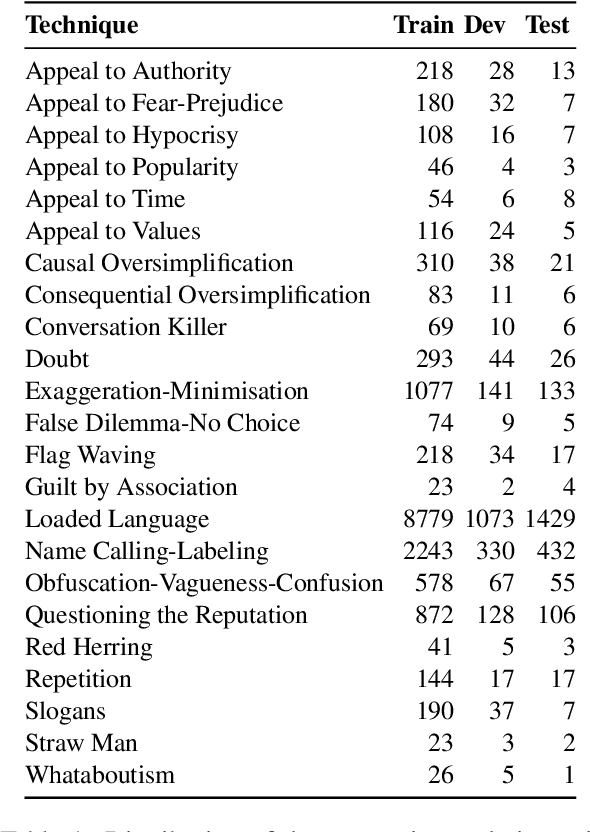

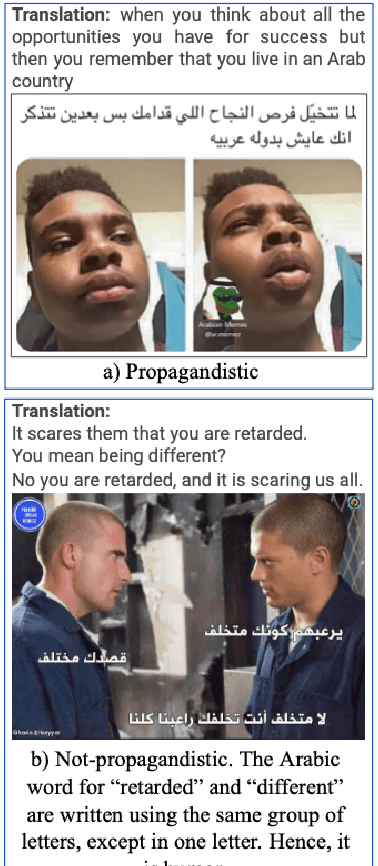
Abstract:We present an overview of the second edition of the ArAIEval shared task, organized as part of the ArabicNLP 2024 conference co-located with ACL 2024. In this edition, ArAIEval offers two tasks: (i) detection of propagandistic textual spans with persuasion techniques identification in tweets and news articles, and (ii) distinguishing between propagandistic and non-propagandistic memes. A total of 14 teams participated in the final evaluation phase, with 6 and 9 teams participating in Tasks 1 and 2, respectively. Finally, 11 teams submitted system description papers. Across both tasks, we observed that fine-tuning transformer models such as AraBERT was at the core of the majority of the participating systems. We provide a description of the task setup, including a description of the dataset construction and the evaluation setup. We further provide a brief overview of the participating systems. All datasets and evaluation scripts are released to the research community (https://araieval.gitlab.io/). We hope this will enable further research on these important tasks in Arabic.
ThatiAR: Subjectivity Detection in Arabic News Sentences
Jun 08, 2024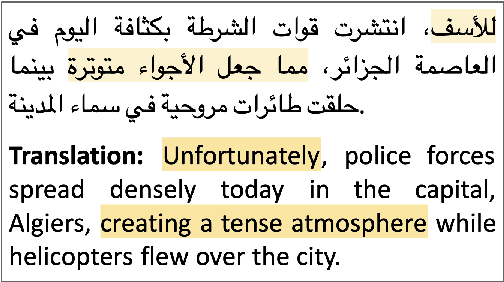
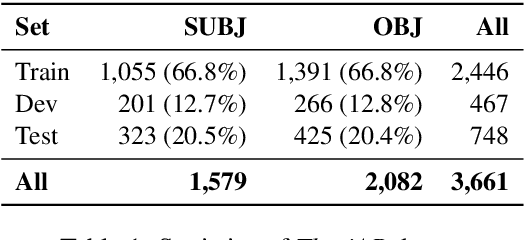

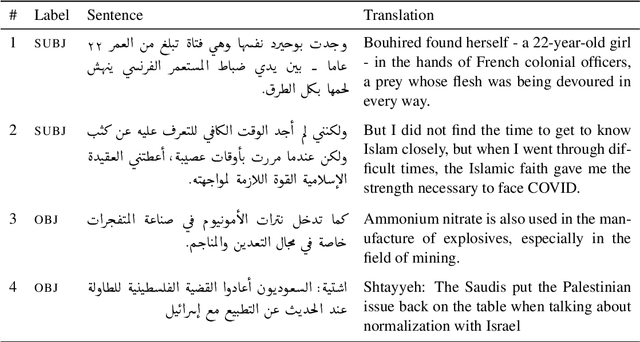
Abstract:Detecting subjectivity in news sentences is crucial for identifying media bias, enhancing credibility, and combating misinformation by flagging opinion-based content. It provides insights into public sentiment, empowers readers to make informed decisions, and encourages critical thinking. While research has developed methods and systems for this purpose, most efforts have focused on English and other high-resourced languages. In this study, we present the first large dataset for subjectivity detection in Arabic, consisting of ~3.6K manually annotated sentences, and GPT-4o based explanation. In addition, we included instructions (both in English and Arabic) to facilitate LLM based fine-tuning. We provide an in-depth analysis of the dataset, annotation process, and extensive benchmark results, including PLMs and LLMs. Our analysis of the annotation process highlights that annotators were strongly influenced by their political, cultural, and religious backgrounds, especially at the beginning of the annotation process. The experimental results suggest that LLMs with in-context learning provide better performance. We aim to release the dataset and resources for the community.
Chinese Offensive Language Detection:Current Status and Future Directions
Mar 29, 2024


Abstract:Despite the considerable efforts being made to monitor and regulate user-generated content on social media platforms, the pervasiveness of offensive language, such as hate speech or cyberbullying, in the digital space remains a significant challenge. Given the importance of maintaining a civilized and respectful online environment, there is an urgent and growing need for automatic systems capable of detecting offensive speech in real time. However, developing effective systems for processing languages such as Chinese presents a significant challenge, owing to the language's complex and nuanced nature, which makes it difficult to process automatically. This paper provides a comprehensive overview of offensive language detection in Chinese, examining current benchmarks and approaches and highlighting specific models and tools for addressing the unique challenges of detecting offensive language in this complex language. The primary objective of this survey is to explore the existing techniques and identify potential avenues for further research that can address the cultural and linguistic complexities of Chinese.
Pushing Boundaries: Exploring Zero Shot Object Classification with Large Multimodal Models
Dec 30, 2023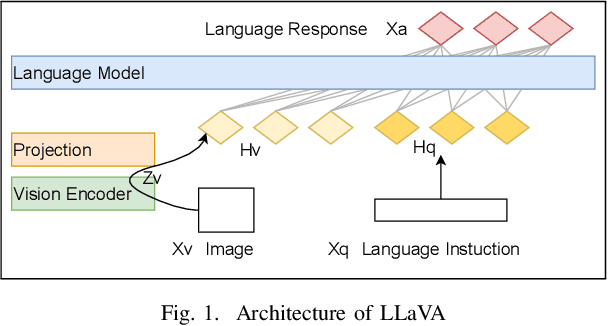
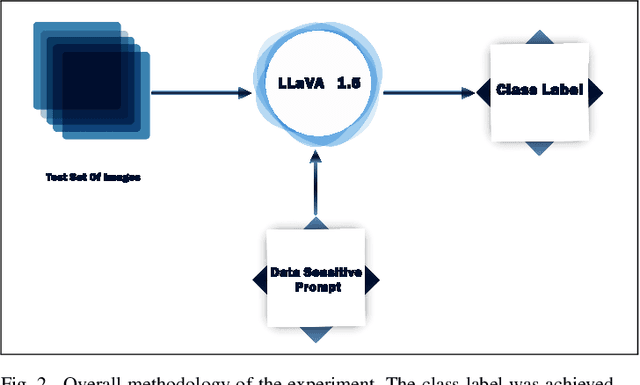
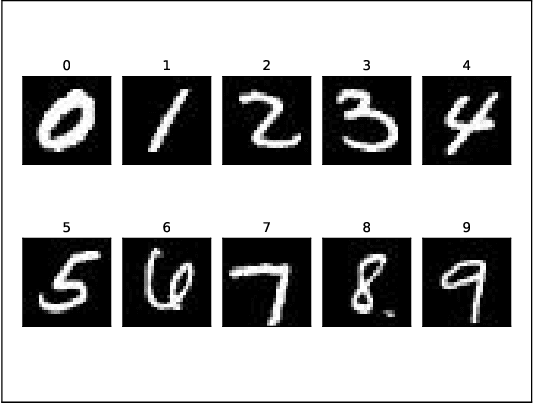
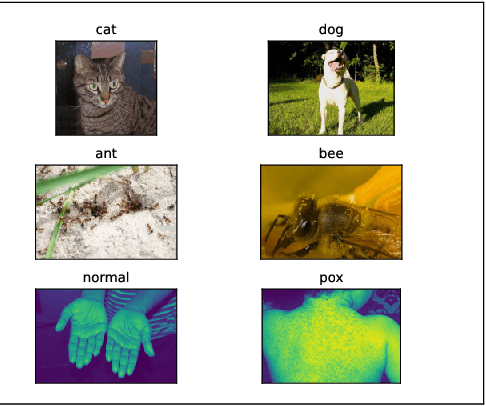
Abstract:$ $The synergy of language and vision models has given rise to Large Language and Vision Assistant models (LLVAs), designed to engage users in rich conversational experiences intertwined with image-based queries. These comprehensive multimodal models seamlessly integrate vision encoders with Large Language Models (LLMs), expanding their applications in general-purpose language and visual comprehension. The advent of Large Multimodal Models (LMMs) heralds a new era in Artificial Intelligence (AI) assistance, extending the horizons of AI utilization. This paper takes a unique perspective on LMMs, exploring their efficacy in performing image classification tasks using tailored prompts designed for specific datasets. We also investigate the LLVAs zero-shot learning capabilities. Our study includes a benchmarking analysis across four diverse datasets: MNIST, Cats Vs. Dogs, Hymnoptera (Ants Vs. Bees), and an unconventional dataset comprising Pox Vs. Non-Pox skin images. The results of our experiments demonstrate the model's remarkable performance, achieving classification accuracies of 85\%, 100\%, 77\%, and 79\% for the respective datasets without any fine-tuning. To bolster our analysis, we assess the model's performance post fine-tuning for specific tasks. In one instance, fine-tuning is conducted over a dataset comprising images of faces of children with and without autism. Prior to fine-tuning, the model demonstrated a test accuracy of 55\%, which significantly improved to 83\% post fine-tuning. These results, coupled with our prior findings, underscore the transformative potential of LLVAs and their versatile applications in real-world scenarios.
* 5 pages,6 figures, 4 tables, Accepted on The International Symposium on Foundation and Large Language Models (FLLM2023)
 Add to Chrome
Add to Chrome Add to Firefox
Add to Firefox Add to Edge
Add to Edge